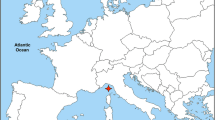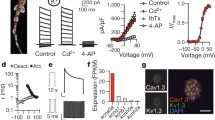Abstract
Electroreceptors with sensitivity in the microvolt range, which mainly function to detect live prey, are well known in phylogenetically old fishes and some amphibians1–4. In African mormyriform and South American gymnotiform fishes this sense has evolved to an active system using an electric organ as a source for impedance measurement of the environment and for communication5,6. Electroreception in higher vertebrates has not previously been reported. Here we establish that the platypus, the Australian nocturnal diving monotreme, can locate and avoid objects on the basis of d.c. fields. High–frequency sensitivity to a.c. could allow the detection of muscle activity of animals, such as crustaceans, which are preyed on by the platypus. Recordings of cortical evoked potentials showed that the bill of the platypus, previously considered to be exclusively mechanoreceptive7–9, is also an electroreceptive organ with behavioural and electrophysiological sensitivity of ∼50 µV cm−1. Several lines of evidence suggest that electroreception has evolved independently in this monotreme.
Similar content being viewed by others
References
Bullock, T. H. A. Rev. Neurosci. 5, 121–170 (1982).
Fritzsch, B. & Wahnschaffe, U. Cell Tissue Res. 229, 483–503 (1983).
Kalmijn, A. J. in Handbook of Sensory Physiology Vol. III/3, 147–200 (Springer, Berlin, 1974).
Scheich, H. in Biophysics, 764–776 (Springer, Berlin, 1983).
Heiligenberg, W. Principles of Electrolocation and Jamming Avoidance in Electric Fish (Springer, Berlin, 1977).
Scheich, H. & Bullock, T. H. in Handbook of Sensory Physiology Vol. III/3 201–256 (Springer, Berlin, 1974).
Bohringer, R. C. & Rowe, M. J. J. comp. Neurol. 174, 1–14 (1977).
Poulton, E. B. J. Physiol., Lond. 5, 15–16 (1885).
Wilson, J. T. & Martin, C. J. Linn. Soc. NSW, Macleay mem. Vol., 190–200 (1893).
Digkgraaf, S. & Kalmijn, A. J. Z. vergl. Physiol. 47, 438–456 (1963).
Himstedt, W., Kopp, J. & Schmidt, W. Naturwissenschaftern 69, 552 (1982).
Crowther, A. B. Pap. Proc. R. Soc. Tasm., 96–99 (1879).
Faragher, R. A., Grant, T. R. & Carrick, F. N. Aust. J. Ecol. 4, 171–179 (1979).
Grant, T. R., Williams, R. & Carrick, F. N. Aust. Zool. 19, 117–124 (1977).
Andres, K. H. & von Düring, M. in Sensory Receptor Mechanisms 81–89 (World Science, Singapore, 1984).
Münz, H., Claas, B. & Fritzsch, B. J. comp. Physiol. A 154, 33–44 (1983).
Bennett, M. V. L. in Fish Physiology, 492–600 (Academic, London, 1971).
Szabo, T. in Handbook of Sensory Physiology Vol. III/3, 13–58 (Springer, Berlin, 1974).
Author information
Authors and Affiliations
Rights and permissions
About this article
Cite this article
Scheich, H., Langner, G., Tidemann, C. et al. Electroreception and electrolocation in platypus. Nature 319, 401–402 (1986). https://doi.org/10.1038/319401a0
Received:
Accepted:
Published:
Issue Date:
DOI: https://doi.org/10.1038/319401a0
- Springer Nature Limited





